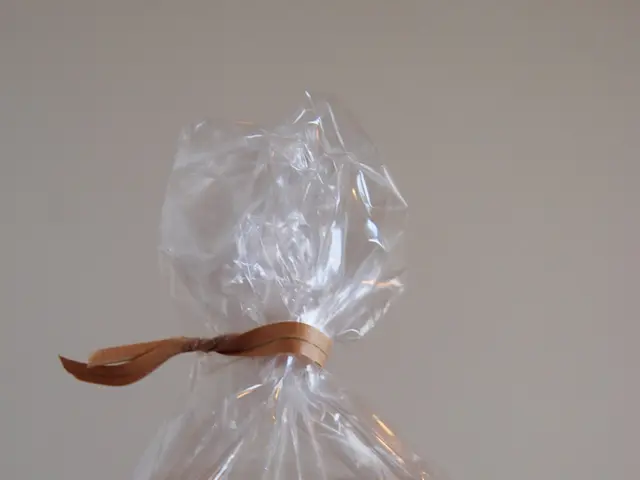Method for Cleaning and Waterproofing a Rain Coat
Rain Jackets: Keep 'Em Dripping (Not With Water)
Hey there, outdoor adventurer or weekend warrior! A must-have item for your wardrobe is a reliable rain jacket. It can turn a soggy day into an adventure day, and for long-distance hikers, a top-notch rain jacket can help you keep going even in crummy weather.
But it's not just about having a quality rain jacket; it needs to be performing at its finest. However, over time, dirt, laundry detergent, skin oil, and sunscreen can contaminate the outer layer of the jacket, interfering with its moisture resistance. You'll notice this as rain no longer beads up on the jacket but instead seeps into the fabric. This is called "wetting out," and it ain't fun.
But relax! Your rain jacket isn't ready for the garbage just yet. Wetting out is merely a sign that it's time to wash and treat your rain gear with the right products. While this may seem like a daunting task, learning how to clean a rain jacket is a breeze—just grab the right tools. Before jumping into the nitty-gritty, let's crack open the hood and learn how rain jackets work.
Washing A Rain Jacket: Break It Down
If you're solely washing a raincoat, opt for a technical wash like Nikwax Tech Wash. This is ideal for waterproof jackets still repelling water but needing a good clean up. Follow these simple steps:
- Read the washing instructions on the label or on the manufacturer's website. Follow those instructions first if they differ from the following.
- Use the recommended dosage of Tech Wash and avoid adding fabric softener, bleach, or powder detergent, as these can harm the membrane and reduce the jacket's waterproofing.
- Zip up all pockets and close all zippers and clasps. Load the jacket into the machine.
- Wash on the delicate cycle. If the soap isn't completely rinsed out, consider running another rinse cycle without adding any additional Tech Wash.
- Add the recommended dosage of Nikwax Wash-In DWR to the soap dispenser of your washing machine. Use the recommended temperature settings (usually low-warm) and run another gentle cycle. Alternatively, if you're using Nikwax Spray-On DWR, follow the separate section below.
- Either air dry or tumble dry on low heat depending on what your clothing label recommends.
- Store your gear once it's completely dry and no sooner. Moist rain gear can lead to mold and mildew buildup in the creases.
- Get back outside!
Now, let's dive into the two methods to apply DWR: Nikwax TX Direct Wash-In or a Spray-On DWR. For rain shells and pants, wash-in is simpler and is the way to go. However, if you're washing a multilayer garment like a down-lined or fleece raincoat, use the spray-on treatment.
DWR Application: Spray Your Way to Dry
If your jacket has down or fleece insulation, the process of washing, drying, and reapplying DWR is slightly different. Be sure to read the washing instructions on your clothing.
For down-lined rain gear, you'll start by using down wash and following the label's cleaning directions. Find a flat surface and protect it with something like a plastic bag or piece of cardboard. Spray the garment, holding the bottle about six inches away, making sure you spray evenly and don't miss any spots. Dab away the residual product with a damp cloth and tumble dry on low heat (if the care label allows).
You can also utilize Down Proof instead of Spray-On DWR for high-quality down fabrics.
For fleece-lined rain gear, follow steps 1-4 above. With this material, there's no need to dry before reapplying DWR. Just find a flat surface and protect it with cardboard or a plastic bag. Lay your clothing flat, spray the clothing from about six inches away from the fabric, evenly coat the outside of the garment, wait two minutes, then dab away any residual product with a damp cloth. You can either tumble dry on low heat or air dry based on the clothing label's recommendations.
Frequency: Wash Away Your Worries
Let's face it; most people probably don't wash their raincoats as often as they should. The apprehension stems partly from fears losing waterproofing, but some comes from the perceived complexity of washing. While the process involves steps, they're quite straightforward. Here are some guidelines to help you know when it's time to wash:
- If you're "wetting out," this is the ultimate sign that it's time to wash and treat your gear. Wash the jacket with the recommended products before the next use if you're at this point.
- For active use such as jogging or hiking, wash your rain gear after 10-15 wears due to the increased buildup of sweat.
- For casual wear, wash after 20-30 normal uses or once a month.
Brief History: Dripping Into The Future
Breathable yet waterproof hit the outdoor gear market in the 1970s, and since then, it's grown in popularity. Gore-Tex was the first manufacturer, but nowadays, every clothing maker and outdoor outfitter has their own line of waterproof clothing. While many people refer to this category of clothing as "Gore-Tex," not all rain jackets are Gore-Tex, just as not all coffee is Starbucks.
Fabric Composition: The Trifecta Of Functionality
Most waterproof clothing consists of three layers: an outer, middle, and inner layer, each with a specific purpose.
The outer layer, known as the face fabric, is typically made of nylon or polyester and is designed to look good, repel, and protect. Although this layer isn't waterproof, it's commonly treated with Durable Water Repellent (DWR), a chemical bond that helps water bead up and run off your jacket.
The middle layer is a waterproof/breathable membrane, composed of microscopic holes that are small enough to let water vapor (sweat and condensation) escape but keep out liquid water (rain) from passing through. This is usually created using Teflon or polyurethane materials.
The inner layer is a tricot mesh, which protects the middle layer from sweat and grime, making it more comfortable against your skin.
For a jacket to be 100% waterproof, it will need taped seams, which are heat-treated seams that prevent water from entering through the stitching. This is particularly important if you anticipate heavy or prolonged rain.
Some jackets can be two-layered, 3-in-1 (not to be confused with three-layer jackets), and parkas.
Waterproof Ratings Uncovered
Commonly, jackets come with millimeter (mm) or gram (g) ratings. But what do these numbers mean?
For everyday use, such as walking the dog or going about town, a rating of 1000m-2000mm is suitable. This rating would also be acceptable for hikers and walkers who aren't likely to experience heavy, sustained rain.
For a serious trek in poor conditions or a range of conditions at home, a rating of 5000-10,000mm is recommended.
Anything higher than 10,000 is considered extreme weatherproofing and is ideal for extremely wet conditions.
These numbers are usually determined by the manufacturer through in-house testing or contracted third-party testing. If you're really into ratings, there are also breathability ratings that might be worth considering. Generally, the higher the grams of water vapor that pass through, the greater the breathability.
Wetting Out: A Soggy Situation
Over time, the chemical bond in DWR wears down, and eventually, your jacket will "wet out." While the main problem is not rain getting into the jacket, it's the sweat and condensation that can't escape. When the outer layer is soaked through, the middle layer can't breathe. And when your body's moisture can't escape, you get soaked from the inside out due to sweat and condensation. This is why it's essential to wash your rain gear with the proper products and maintain the DWR outer layer.
Wrapping Up: Don't Sweat It
Maintaining a good layer of DWR can sometimes take the back burner, but it's crucial to prevent wetting out. In fact, writing this guide has reminded me that I need to treat our rain gear sooner rather than later! But seriously, regularly clean your waterproof garments to prevent wetting out and keep them clean. Make sure to follow the instructions on the care label, and here's to happy hiking!
Related Post: Best Rain Ponchos For Hiking
FAQs
Can I put my rain jacket in the washing machine?
Yes, you can put your rain jacket in the washing machine. Just be sure to check the care instructions on the label first. If your jacket is machine-washable, use a technical wash like Nikwax Tech Wash to clean it and preserve its waterproofing. Never put a wet or damp jacket in the dryer, as this can damage the fabric and reduce its lifespan. Instead, let it air dry.
How do I clean a smelly raincoat?
To clean a smelly raincoat, use Nikwax Tech Wash. This product is designed to clean waterproof gear without causing damage. Follow the care label for specific instructions, and make sure not to use regular detergent, as it can harm the waterproof coating.
How do I restore the water repellency of my raincoat?
To restore the water repellency of your raincoat, use Nikwax TX.Direct Wash-In. This product will re-coat the fabric with water repellent, helping it bead up and repel water again. Apply the treatment during the wash cycle, as directed on the label. You can also use Nikwax Spray-On DWR for targeted areas or delicate fabrics. After applying the spray, allow it to dry before heat-setting using a hairdryer or iron. Avoid overheating the fabric to prevent damage.
- For outdoor enthusiasts, it's essential to maintain the waterproof and breathable performance of their rain jacket, especially during long-distance hikes in unfavorable weather.
- When your rain jacket starts to "wet out," indicating that water no longer beads up on the jacket but instead seeps into the fabric, it's time to wash and treat it with the right products.
- Learning how to clean a rain jacket is a straightforward task, and using a technical wash like Nikwax Tech Wash can help keep waterproof jackets clean without harming their waterproofing.
- Regularly washing and maintaining your rain gear ensures optimal performance, preventing "wetting out" that can lead to discomfort during outdoor activities like hiking, or even daily activities that expose your jacket to sweat and grime.







